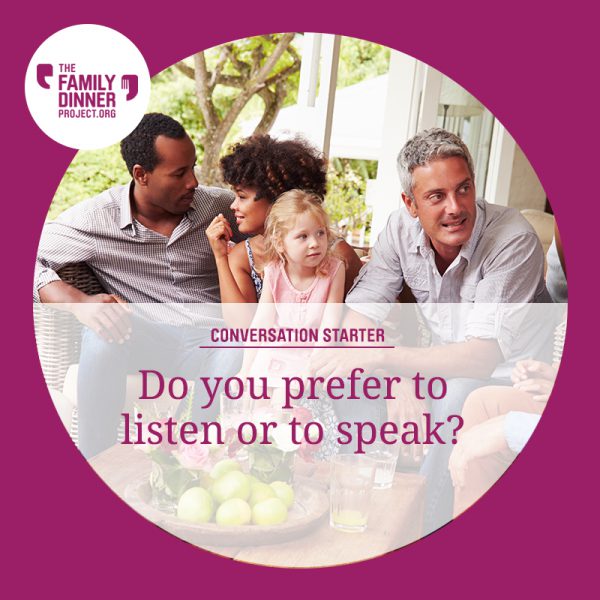Newsletter: July 2018
Practicing Courtesy at Family Dinner

Courtesy seems to be a big topic these days. Whether it’s mourning a seeming decline of social graces like shaking hands and holding doors, fretting about lack of civility in conversations or sighing over the way communication seems to have moved towards digital rather than face-to-face interactions, almost everyone you talk to probably has some opinion to share about the role of common courtesy in our everyday lives.
July happens to be National Cell Phone Courtesy Month, and that puts us in mind of all the different ways that the family dinner table can be used to practice courtesy — not just technological, but of all kinds. Here are our top tips for making the dinner table a civilized place to be this month, even if there are elbows sharing space with your plates!
Be Clear and Realistic About Expected Manners
Good table manners are a lovely goal, but few of us are born ready to be model guests at Buckingham Palace. Consider developing manners a journey rather than a set of expected behaviors that have to be perfect every night. It helps to be realistic about your family’s ages and stages — what’s acceptable from a 3-year old will be different from what your 10-year-old can do, and what helps a child with ADHD participate positively in family dinners may differ from what you might expect from another child their age.
Not sure where to start? We encourage you to begin with the behaviors that are really about showing courtesy and kindness to others. For example:
- Saying “please” and “thank you”
- Asking to have dishes passed, and passing them nicely
- Not reaching across others’ plates
- Not interrupting when others are speaking
These skills, and others like them, translate well from the dinner table to other social situations, making them good ones to master before you move on to meal-specific manners like napkins in laps and using forks instead of fingers. (Though those are important skills, too!)
For more on manners, check out Rules, Rules, Rules or May I be Excused, Please?
Model Good Conversational Skills
Taking turns while speaking and using respectful language are a strong foundation for showing courtesy in a conversation, but they’re only the beginning. Especially as kids get older, it’s important to teach them how to handle some of the more difficult aspects of communication. If they disagree with someone, how can they express that politely? How should they engage with someone in a respectful dialogue if they don’t agree, and stay open-minded to the other’s point of view? If someone says something offensive, what’s the best way to handle the situation? All of these are challenges that come up frequently in adult conversations, and the dinner table is a great place to help your whole family develop their skills in dealing with tricky conversations.
Try starting with our Guidelines for Meaningful Conversation, and see if your family can stick with these courtesies:
- Practice Positivity: No name-calling or complaints! Try to choose topics that make people open up instead of shutting down.
- Listen to Understand, Not to Respond: Show active listening with eye contact and open body language. Ask yourself “Am I hearing the feelings or meaning behind their words?”
- Reframe with Respect: If you hear something concerning, try to investigate first. Say “I think I just heard you say…” and restate. Or ask “I’m curious about….” or “Can you explain what you meant by….?”
- Welcome People, Not Arguments: If a conversation becomes heated, try saying “I hear you, and I am open to talking about this more later. For now, can we try to enjoy each other’s company? Let’s talk about something else while we cool off.”
- Get Everyone Involved: Make sure that everyone at the table has a chance to participate. If someone seems particularly quiet, try asking them a direct question or offering a compliment so they feel included, or invite them to suggest a new conversation topic.
- Share a Smile: Whether it’s a literal smile on your face, a warm gesture or a joke or silly story, it’s important to know (and learn when to use) some strategies to help keep tension at bay.
Get more in-depth ideas for making the most of conversation with Dr. Anne Fishel’s tips on Creating Meaningful Conversations.
Set Tech Boundaries That Work For You
Whether it’s cell phones, tablets, computers or television, managing technology at the table can create a tricky etiquette situation. Some families may choose to go entirely device-free at dinner to avoid the problem altogether, but that may not be the solution that works best for your mealtimes. If tech is a potential guest at your dinner table, we encourage you to use it mindfully, especially as you’re working to model courtesy this month!
Try these tips to help find the boundaries that are right for you:
- Put devices in their place. Try creating a holding area where digital devices can be placed during your meal, so you only reach for them when necessary rather than checking them throughout dinner.
- Use devices to promote conversation and togetherness, not distract from them. For example, you might use your phone to look up the answer to a question or to remember a funny joke you wanted to share, but not use it to play Words With Friends while someone is trying to talk to you.
- Stick to communicating with the people who are present. Unless there’s an emergency and you have to take a call or text, show courtesy to those at the table by trying not to carry on a separate digital conversation while you’re eating.
- Schedule dinners with devices, and those without. For example, you might try one dinner per week without technology, or if device-free is more the norm for you, allow Friday night movies during mealtime.
Having trouble setting boundaries? Check out the Technology Tips from our 4-Week Program for better family dinners.
Teach “Soft Skills”
We love the tips in this article from our friends at Common Sense Media about reinforcing “soft skills” like kindness, empathy and courtesy. If you do try that Friday night movie with your dinner, you might use some of their ideas about choosing media that reinforces the messages you want your family to learn.
Family of the Month
Meet the McGrath family from Australia! While dad’s away for a while, mom is using family dinner to promote togetherness – and prepare four kids for an international move.
Real Family Dinner Projects: The McGrath Family
Food
Take advantage of summer berries to make an easy dessert with a not-so-courteous name!
Fun
Model kindness and positivity with a round of “20 Things I Love About…” For a twist on the challenge, list 20 Things you love about each person at the table!
Conversation
Try this question to open a conversation about the value of listening.

Recent Newsletters
- When Picky Eating Might Be Something More - July 2024
- Feeling Lonely? Share a Meal. - June 2024
- Welcome to May Madness - May 2024
- Family Dinner Has Gotten Expensive - April 2024
- Is it the Family, Or the Dinner? - March 2024
- Black History Month at Family Dinner - February 2024
- New Year, Same You - January 2024
- Sharing the Holiday Load - December 2023
- What’s Your Thanksgiving Story? - November 2023
- Family Dinner: Stressful, or Stress-Busting? - October 2023
- New Ways to Ask “How Was Your Day?” - September 2023
- Low Stress, Low Cost, Low Waste Dinner Hacks - August 2023


